Windows Phone 8.1 Review
by Anand Lal Shimpi on April 14, 2014 10:00 PM EST- Posted in
- Smartphones
- Microsoft
- Mobile
- windows phone
- Windows Phone 8.1
Wi-Fi and Data Sense
Windows Phone 8.1 includes automatic handling for a large number of WiFi hotspot captive portals. If enabled, your phone will automatically agree to any terms and even automatically provide a name and email address to get you past the portal.
The new Wi-Fi Sense feature also allows sharing of Wi-Fi credentials with other WP8.1/Wi-Fi Sense users. The users on the other end never see passwords, they’re just automatically allowed to join networks you choose to share. This is one feature I wasn’t able to test as I only had a single WP8.1 device.
Where Wi-Fi Sense attempts to make joining Wi-Fi networks easier, Data Sense tries to help you manage bandwidth usage on cellular networks. The new tool gives you insight into how much bandwidth all of your apps are using, down to a split between cellular and WiFi traffic.
You can input how much cellular data you’re allocated each month and Windows Phone 8.1 can automatically monitor your cellular data usage and respond appropriately as you approach your data limit. WP8.1 can restrict background data usage, as well as reduce bandwidth requirements for Internet Explorer.
With IE11 on Windows Phone 8.1 Microsoft introduced optional server side web page compression. Similar to Amazon’s Silk browser’s accelerated page loading, Microsoft’s Browser Optimization Service (BOS) uses a proxy server to compress images, HTML and JavaScript before sending the contents to your device. MS claims to not store any personal data during the process. When enabled (either manually or automatically triggered by Data Sense), Microsoft claims the compression can save up to 45% of your browsing data usage in standard savings mode or up to 70% in high savings mode.
I setup a web server and looked at the impact of BOS on image compression. Below are some samples taken from our Galaxy S 5 review when viewed in IE11 with BOS disabled, standard savings enabled and with high savings enabled.


With the most aggressive compression enabled, the impact on file size and image quality is pretty substantial. Microsoft provides a simple override if you want to load a full quality version of the page without diving back into the Data Sense settings.

Tap the override symbol (to the left of anandtech.com) to load the full web page
The standard compression image honestly doesn’t lose a ton of quality, but the savings on already compressed images aren’t huge.
| BSO Impact on Image Sizes | ||||||
| No Compression | Standard Compression | High Compression | ||||
| Night Shot (Image #1) | 57KB | 41KB (71.9%) | 38KB (66.7%) | |||
| Product Shot (Image #2) | 284KB | 253KB (89.1%) | 182KB (64.1%) | |||
In high savings mode IE11 will also prevent loading long pages and avoid loading some ads. Visiting AnandTech’s mobile site with BOS set to high revealed a mostly useless front page with nothing more than the main logo but that seemed to be the exception as we have a rather image heavy front page. As it’s optional, I can see BOS being important to some users on aggressively capped data plans.
IE11
There’s a running joke at AnandTech that the only thing mobile IE10 was optimized for was SunSpider. While javascript performance optimization has become a primary pursuit in Android and iOS, the only javascript test that seemed really fast on IE in Windows Phone 8 was SunSpider. If I ran any of our less well known js tests I either got scores that represented phones from a couple of years ago or the browser couldn’t complete the test. Windows Phone 8.1 integrates IE11 and with it comes a number of performance optimizations.
SunSpider doesn't show a meaningful increase in performance (likely because it's already thoroughly optimized for). The good news is the rest of our js suite does get substantially better:
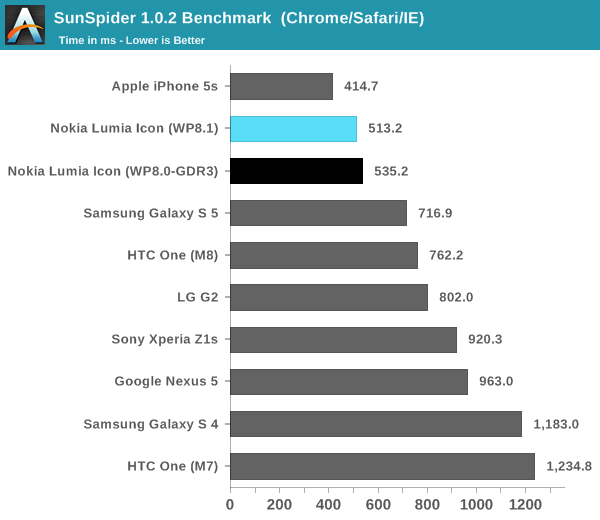
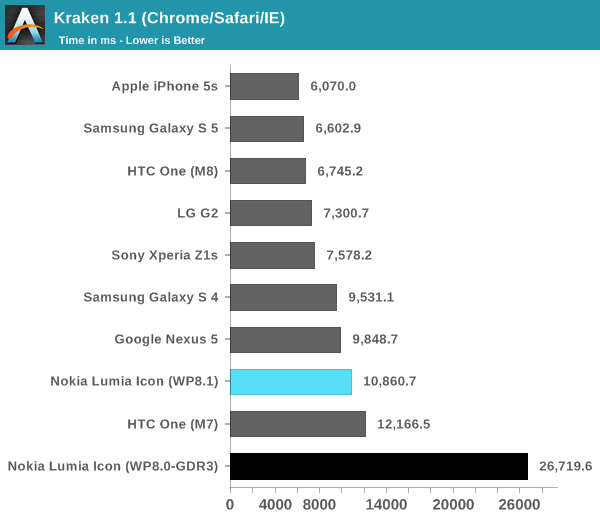
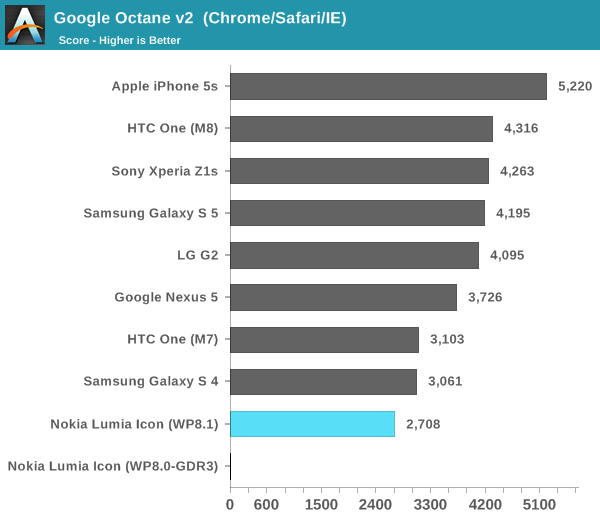
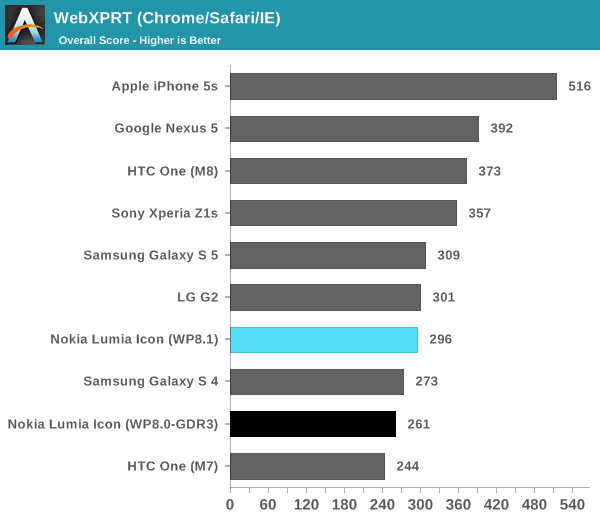
Kraken completes in less than half the time than it did in WP8.0. Octane actually completes now instead of hanging during the asm test, and WebXPRT sees a 13% increase in performance as well. IE11 definitely isn’t the fastest mobile browser on the planet, but it at least moves WP8.1 towards a more modern level of performance. Note in the case of WebXPRT running on the Lumia Icon, we're at performance that's nearly equal to the LG G2 - also using a Snapdragon 800 SoC. That's one of the slowest examples of S800 running Android however. The Nexus 5 by comparison does substantially better - there's still room for improvement in IE11's js performance.
I did notice improvements in actual page load times however it seems to me that there’s a bit of image compression going on even when I have Data Sense disabled which effectively invalidates any comparison results. It’s not clear to me if this is intentional or a bug with the dev preview at this point. In side by side comparisons, Mobile Safari running on the iPhone 5s still manages to load pages faster than IE11 running on the Lumia Icon, despite whatever image compression may be active on the WP8.1 device. It just goes to show you that having the fastest silicon does matter.
IE11 is more compatible than its predecessor. Running HTML5Test the new browser gets a score of 378, compared to 328 in IE10. Chrome for Android and Mobile Safari both score higher however.
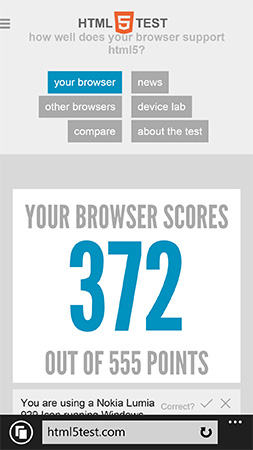
I’ve included a screenshot gallery showing the individual scores, but the new browser wins a lot of points by including support for things like WebGL. Despite adding WebGL support however, I couldn’t get the old aquarium test to actually animate on the device.
IE11 sees functional improvements compared to its predecessor as well. The refresh button at the bottom of the screen has been replaced by a tabs button (you can change it back if you’d like). You can now also swipe right/left to go back/forward through your history in a tab. There’s better YouTube support with IE11 as well. You can now play YouTube videos within an embedded page instead of always being forced out into a full screen mode.
Performance
Since its incarnation, Windows Phone has always been late in adopting high end silicon. It normally wouldn’t be a problem if the platform primarily targeted entry level and mainstream consumers, however for much of its recent life Windows Phone has pursued the high end particularly with Nokia’s flagship devices. The result was a platform that had a high end camera, but with a mainstream SoC. It wasn’t too long ago that Microsoft was parroting the dual-core isn’t necessary for performance and is bad for battery life mantra, but it’s good to see that’s now over with.
Qualcomm remains the sole silicon provider for Windows Phone, which is fine given their position of dominance and the lack of any appreciably better alternatives. With the GDR3 update to Windows Phone 8 Microsoft added support for Snapdragon 800. Although that SoC has since been superseded by the Snapdragon 801, Windows Phone 8/8.1 at least support the highest end mobile silicon family available today.
The Lumia Icon was my first Windows Phone experience on Snapdragon 800, and I have to say it is quite good. Launching and switching between apps is pretty quick and the OS as a whole feels nice and responsive. Having spent the past few weeks in Android and iOS 7.1 land, the Windows Phone 8.1 UI animations seem a bit excessive but no where near as bad as iOS 7.0. The platform overall is quite pleasant to use and never really feels slow, at least with the S800 under the hood.
There are a few native benchmarks available on the Windows Phone Store, which I used to track changes in system performance between WP8 and 8.1. I didn’t find much of a delta between the two platforms:
| Windows Phone 8.1 vs. 8.0 GDR3 Performance | ||||||
| BaseMark OS II | BaseMark X 1.1 (Medium, Overall) | GFXBench 2.7 (T-Rex HD, Onscreen) | ||||
| Windows Phone 8.1 (Lumia Icon) | 1046 | 25536 | 25 fps | |||
| Windows Phone 8.0 GDR3 (Lumia Icon) | 1033 | 24748 | 25 fps | |||
The individual BaseMark OS II scores are worth drilling down on as they expose the improvements in web rendering performance, as well as highlight a slight regression in some of the other areas:
| Windows Phone 8.1 vs. 8.0 GDR3 Basemark OS II Performance | |||||||
| System | Memory | Graphics | Web | ||||
| Windows Phone 8.1 (Lumia Icon) | 921 | 1492 | 1409 | 619 | |||
| Windows Phone 8.0 GDR3 (Lumia Icon) | 1146 | 1474 | 1192 | 566 | |||
The slight drop in system performance (these are mostly CPU bound tests) is unusual, but this is a dev preview of WP8.1. IO performance (memory suite) doesn't change, but graphics and web performance both go up. I suspect there are some improvements on the GPU driver front, which are responsible for the uptick in graphics performance. The increase in web rendering performance is also made evident here.


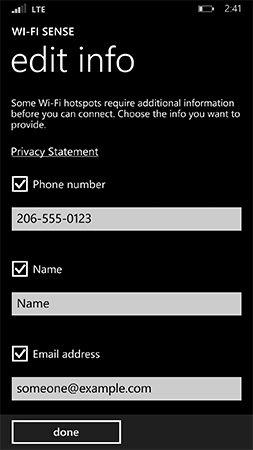
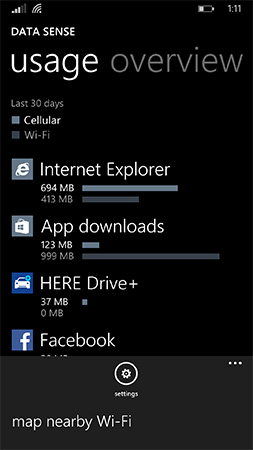
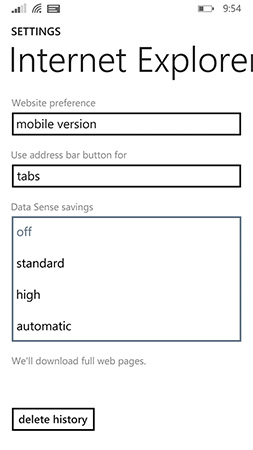
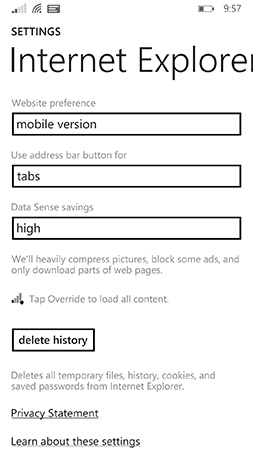
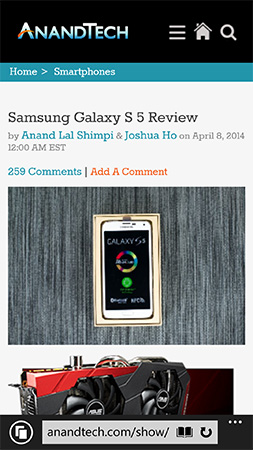














111 Comments
View All Comments
BSMonitor - Tuesday, April 15, 2014 - link
Microsoft needs to throw serious $$ at marketing to developers. Looked at my brother's phone for a few simple apps, Comedy Central, Cosmos, Clash of Clans, etc... No go. It's not the small crappy game developers we are talking either. It is the big corporations. Corporations who are "competing" (aka throwing cash) by having their App presence out there.They aren't even creating Apps for Windows. I.e. Chase, Discover, Direct TV, etc etcApple has done to Microsoft what Microsoft did to them in the 80s/90s.. "See, all this software, it will run on ours, but not on yours".
For me to switch. I would need x86 Windows Phones.
Duraz0rz - Tuesday, April 15, 2014 - link
Chase actually has a mobile app since the WP7 days. I think they even keep it up to date."For me to switch. I would need x86 Windows Phones."
For what?
MikhailT - Wednesday, April 16, 2014 - link
He's probably trying to emphasize the important of the ecosystem behind the OS, not the actual x86 hardware. Think of Surface Pro, it's a great tablet with a big ecosystem because you can switch to the desktop to download x86 apps for any apps missing from the Windows App Store.For him to consider switching to WP, it'd need to have a large amount of software comparable to having a Surface Pro shrunken to the phone model. Right now, it's just not there, it's missing too many apps.
Duraz0rz - Wednesday, April 16, 2014 - link
That would make sense. More often than not, the sites he mentioned have a good mobile website (Discover and American Express have a good one, IIRC), but we are missing "cool" apps like Lyft and Uber.Arbie - Tuesday, April 15, 2014 - link
I have a Nokia 520 Win8 phone and like it very much, especially at the $150 total price for an unlocked international version.My main gripe is lack of a WHITELIST feature. Why can't a smartphone check incoming calls against a list and only put my friends through? I get dozens of idiot spam texts and voicemails.
--> Whitelist should be a no-brainer fundamental built-in capability of every modern phone and certainly of every smartphone.
Oh, and never mind trying to suggest such an amazing idea to MS - their feedback website has evidently been hacked (for a year or so) and is submerged in tens of thousands of bogus requests. Eventually they may figure this out... they are a fairly large company after all, with some tech knowledge.
Duraz0rz - Tuesday, April 15, 2014 - link
Not sure where you live where you get dozens of spam texts and voicemails. I don't get that here in the US, but I'm sure the telco blocks a lot of that here.If you were in the US (or wanted to set up your phone so you can use Cortana), you can use Cortana as a whitelist of sorts. Have Quiet Hours on all the time, set up your Inner Circle with the people you want to get through, and have their calls and texts always break through quiet hours.
Tewt - Tuesday, April 15, 2014 - link
Get Magikmail for your whitelist feature. I first used it when I had a Samsung Focus and continued to use it on my Galaxy S3 and will get it again when I purchase a WP8 phone. I may have missed it but I did not see that Android had this feature built in either.dazaein - Wednesday, April 16, 2014 - link
A whitelist feature is included in 8.1. "Quiet Hours + Inner Circle." But it sounds like you just need a clean sim number..erple2 - Sunday, April 27, 2014 - link
When my wife finally entered the smartphone era (2012), I gave her my old phone sgs2 on at). I had to get her a new number, as she didn't want her other number from a couple of states away. The first two numbers she got received spam texts from hourly (first number) to every 4-6 hours. The third number I got for her workedLike a charm. Either way my experience with the provider (att) taught me two things: they don't block ANY text messages at all (for me, it was 20 cents per text message so they have a vested interest in NOT blocking junkspam, and their blocking services, which are a blacklist only, costs money per month), and its easy to get a recycled phone number that used to subscribe to text ads.
In other countries, text spamming is illegal.
SpartanJet - Tuesday, April 15, 2014 - link
Really looking forward to purchasing a Windows 8;1 phone. It has everything I want in a phone OS and I can finally completely remove myself from any gogle service once I get rid of my ADroid phone. I just hope Tmobile gets a high end Windows phone similar to the 1520 or else I'm going to have to switch carriers.